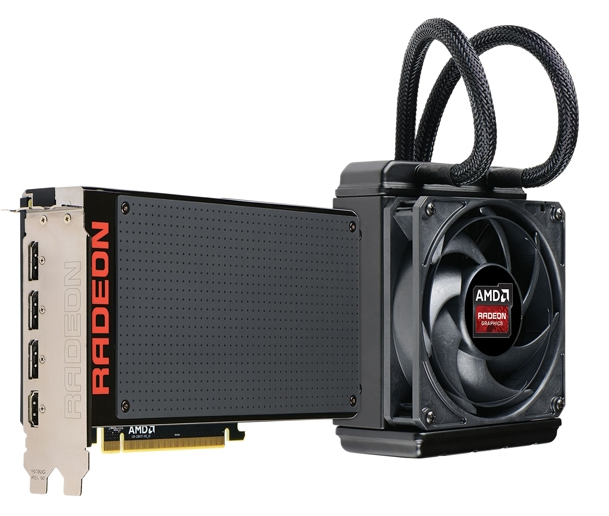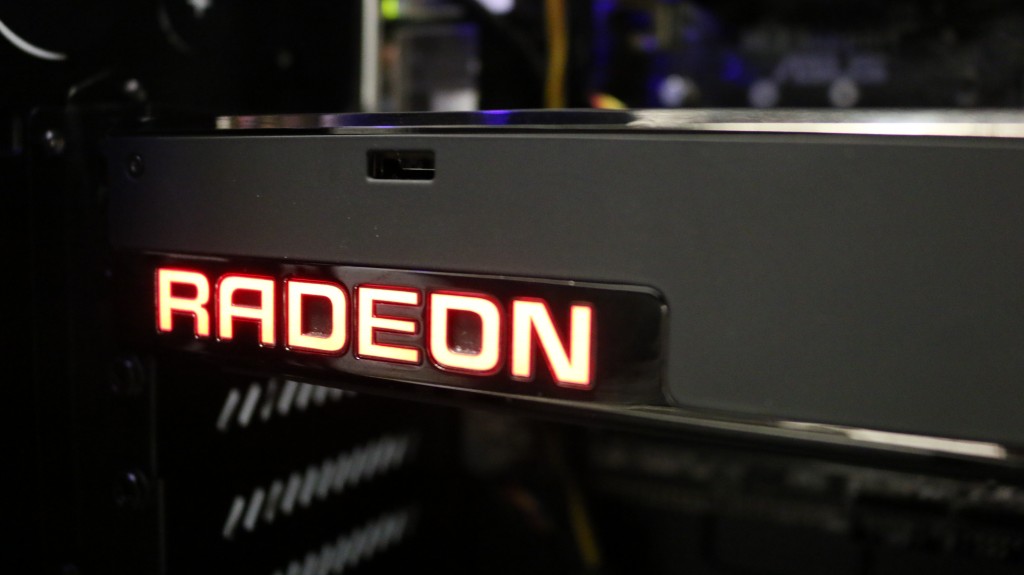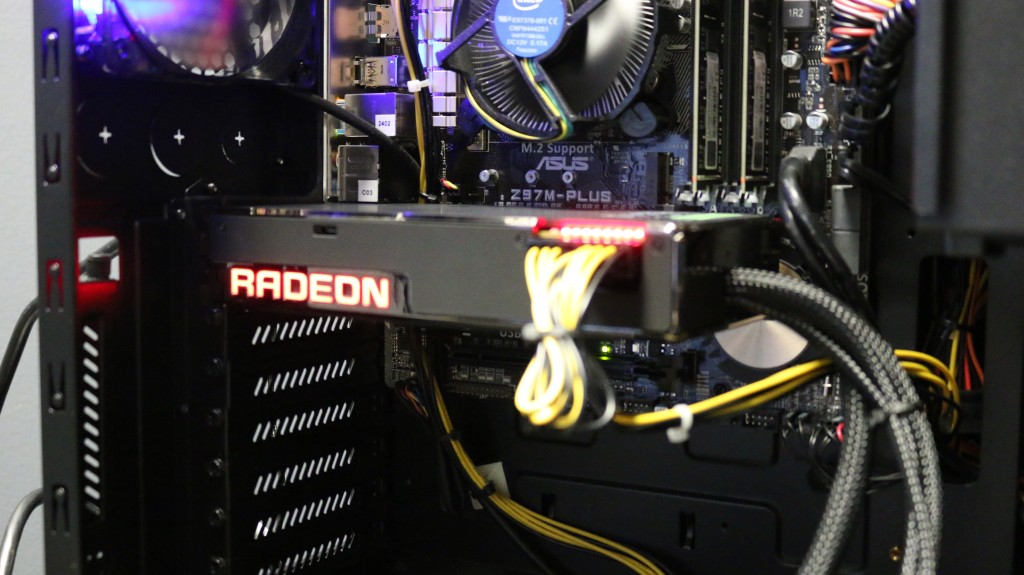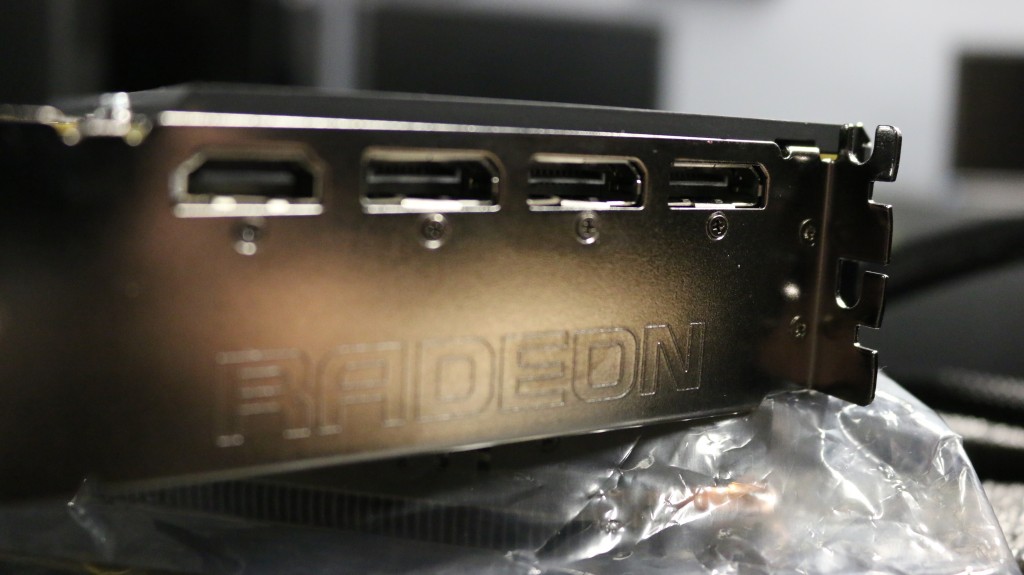
AMD has topped their 390X with a new Series known as FuryX. This new card has some exciting features that won’t just win now, but keep you winning tomorrow.
The Fury Roadmap (what a day…. what a lovely day)
R9 FuryX – Liquid cooled version (The version we tested)
R9 Fury – Air cooled version
R9 Nano – Even smaller form factor card coming in at 6”
What Does It Look Like?
The sample we received was the liquid cooled version. It’s a standalone unit like we have seen with other Radeon cards, but the card itself is very compact and clean. The FuryX card is wrapped in a black nickel roll cage with matt black panels. Its sleek and smooth design looks great. The card has some bright LED’s that remind me of a classic graphic equalizer showing off its spikes in LED glory. There are two dip switches on the back and one on the side where the crossfire port would normally be located. Don’t worry, crossfire no longer requires a cable.
The card itself is double height and around 7.5” in length which means it will probably fit in just about every ATX case out there. It is permanently attached to two hoses and a power cable. It takes two 8-pin connectors to power the beast. However, it’s very quiet at idle. The hoses lead to a 120 mm fan and radiator which should be mounted to replace a back fan. The hoses are around 14” long, so keep that in mind when picking your case.
What Are The Specs?
Stream Processors: 4096
TFLOPS: 8.6
Memory Size: 4GB
Core Clock: 1050MHz
Memory Clock: 500 MHz
Memory Bandwidth: 512 GB/s
Memory Interface: 4096-bit HBM
The Difference Is In the Details
The R9 Fury has a new architecture which will allow for a smaller, quieter card, while offering the performance only seen before at top levels. This card is quite a change from previous series. We hope this is the start of a new generation of cards in performance and size.
HBM and You
One of the great features of AMD’s Fury is the high bandwidth memory or HBM for these cards. This is a move away from the traditional 32-bit interface to be similar to hyper-threading styles. Think of it like shipping, at some point a bigger or faster truck doesn’t increase performance and it’s time to put that load onto a train. This also reduces the amount of printed circuit board (PCB) needed for video cards in general. Smaller PCB’s means we’ll likely see Fury style performance in future gaming laptops too.
Who Should Get This Card?
These Fury cards are perfect for those who want the highest performance for the lowest price. It sounds well suited for those who plan on running 4k monitors at the highest settings. It’s also perfect to power VR products we’ll be seeing soon. It also has a compact design which makes it perfect for nearly any system configuration. I’m sure we’ll see these cards in top builds as well as desktop steam boxes.
Alright, Let’s See Some Benchmarks
We managed to run some benchmarks on our ABS Commander system. It’s running an Intel I5-4690k on 16GB mem and 120 GB SSD/1TB SATA.
3DMark
Skydiver: 24503 (5% Increase over 390x)
Fire Strike Ultra: 3833 (27% increase over the 390x)
Fire Strike Extreme: 6802 (24% increase over the 390x)
Tomb Raider at 1600: Min.: 58.0 Max: 62.0 Avg. 60.0
Tomb Raider Ultra: Min.: 58.1 Max: 60.1 Avg.60.0
Metro Last light at 1600: Average 37.0 Max 76.30 Min 3.30
Metro Last light at 1080: Average 62.67 Max 117.22 Min 3.25
This card clearly shines at higher resolutions. We also expect these benchmarks to improve with newer drivers as we head to Directx12.
It Only Gets Better with Age
The card is pretty good already in terms of benchmarks. However the best part about this card is it will take Directx12 to unlock its full potential. It will continue to boost benchmark numbers as we see developers build around the new hardware. The card is literally designed with the future in mind. It should have a pretty good lifespan.
Will It Clash with the Titans?
It’s hard to tell this early how well this card will do against its rivals, but one thing we know is the card war never changes. Both teams always have a few more tricks up their sleeves. The fight will truly begin with the launch of Windows 10 this year, and it’s going to be an exciting time to be a gamer. If you like this article and like to see us make more benchmarking blogs let us know in the comments, and tell us what your predictions are for the future of video cards.
If you enjoyed this article check out our video for more info on the R9 Fury X




